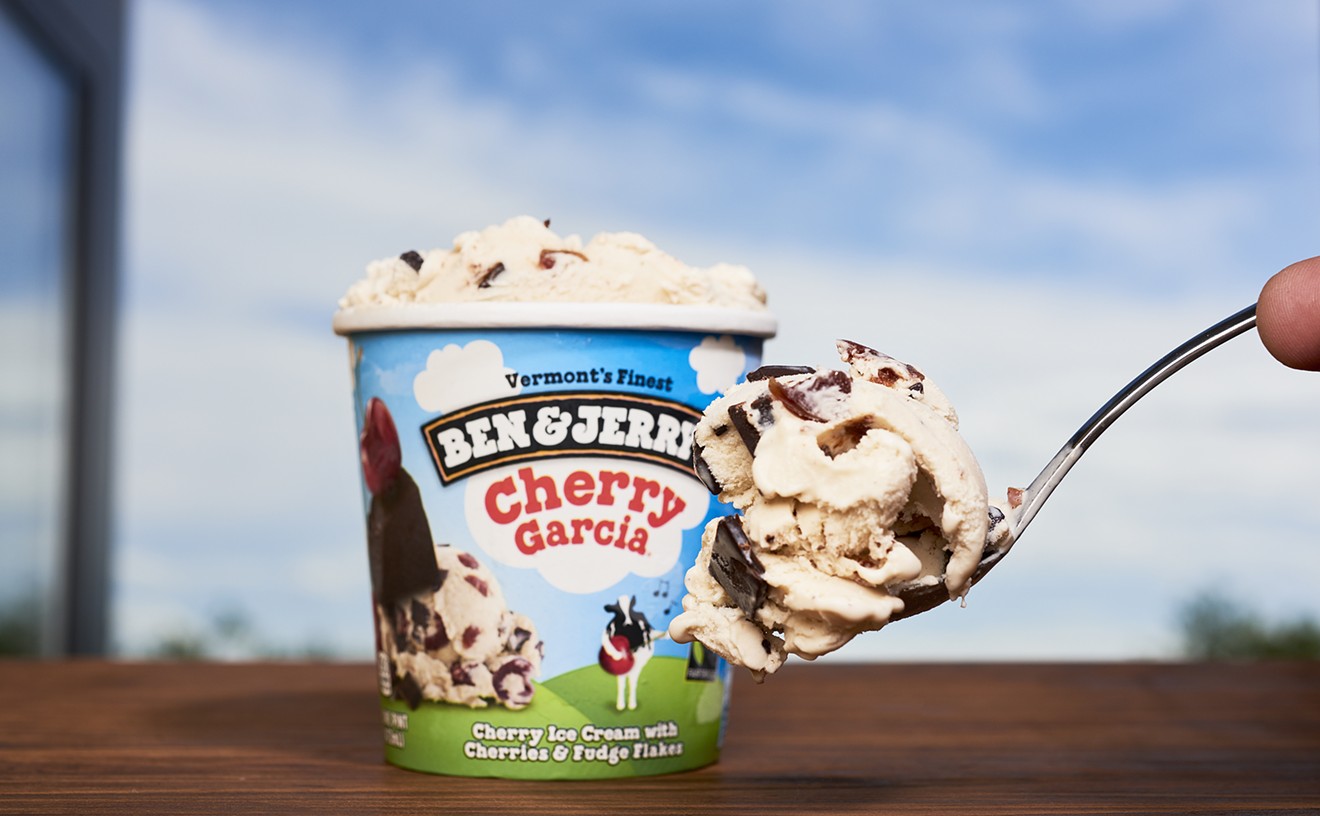You don't usually think of a place with a take-out fish counter as a fine-dining restaurant, but that's exactly what TJ's Seafood Market & Grill in Preston Hollow is. When you walk through the doors, you almost don't even notice the case full of fresh fish, mussels and clams. Instead, you're too busy wondering what the hell smells so damn good and gazing longingly at that beautiful cocktail menu.
Executive Chef Nick Harrison is a relative newcomer to the Dallas food scene. Outside of stints with Stephan Pyles and Abraham Salum, you probably don't recognize Harrison from any of your other favorite haunts, because he's been jet-setting across South America as a private chef. Now he's settled down at TJs, and he's got his sights set on an empire. I sat down to talk with Harrison about his crazy-strong culinary resume, cooking in the shadows of TJ's 25-year seafood legacy, and working with Dallas' biggest fish nerd, Jon Alexis.
You bring a pretty extensive kitchen background to TJ's Seafood Market, but you're mostly an unknown quantity for people in Dallas. What's your story? I'm unknown here because I spent the last eight years in South America. I just got back about a year and a half ago. I started out at Le Cordon Bleu for culinary school, then moved back to Dallas and worked with Abraham Salum at his restaurant. It was a great experience and taught me a lot about working in a restaurant of that caliber. We changed the menu there every month, so I was very used to turning and burning when it came to dishes.
After that, I started working with a private equity fund as a private chef, and that's how I ended up in South America. They opened a private equity fund in Chile, and they asked me to come along with them. I cooked a while for them doing private cheffing and private events, and I opened The White Rabbit in Santiago de Chile, which is really a happening little American-style French bistro. After that I did some jumping around. I worked with Frances Malmann for a little while in Mendoza, and he's a really incredible chef.
Then I came back to Dallas, worked with Stephan Pyles and helped him open Sky Canyon at the airports, and that was a really different experience for me. Having to go to work through TSA every day and be FBI background checked for a job was pretty weird. That's actually where [owner] Jon [Alexis] found me. He pulled me aside, and we talked about food, and it all kind of went from there. The one thing I skipped over in that was that I did an internship at The French Laundry.
Wait, you skipped over that? How do you not mention a job at The French Laundry? Well, after culinary school I did an internship at The French Laundry, but I wasn't a sous chef or even a line cook. I was an intern, and I peeled potatoes at The French Laundry. It was a humbling experience. They have a great kitchen and everything is an amazing experience, so I also won't play it down, either. Peeling potatoes at The French Laundry is pretty cool.
What interested you about this style of restaurant after such a diverse bunch of experiences? Working with Stephan Pyles is amazing, and I really liked it there. However, fish is one of the places I never went. I spent time at Salum and all these other places that focused on just about everything but fish, and it's always been one of my passions. After living in Chile, which has more coastline than anywhere else in the world, fish is a huge thing there. I learned a lot of cool tricks. Even when I worked there, though, the restaurants focused on steak and other dishes like that. So seafood was kind of an unknown for me, but I thought it would be a great experience, and an opportunity to flex my muscles in an area that I'm not familiar with.
Even though you weren't really cooking South American food when you lived there, do those flavors influence your menu here at TJ's? Mostly, I was the guy who was bringing the American flair to these South American restaurants, so I missed out on being able to accomplish anything in terms of that cuisine while I was there. But living there, you have to eat there, and I love South American cuisine. Chilean cuisine not so much, it's a lot like American food. Most of the restaurants are something else -- Italian, German, Croatian, whatever. That's why I went so far as an American chef there. As far as flavors, though, I love Peruvian food. It's so fresh, they have such great local agriculture there. Literally everything is grown within a 500-mile radius. Argentina also has really great food.
Where do those flavors come through on the menu, though? Our Peruvian ceviche is as close as I can get to something that is actually Peruvian ceviche without offending the American palate. In Peru, it's these huge chunks of corvina barely dressed in lime. It's not cooked at all, and the American palate is a little more used to ceviche that's taken on a little more of the citrus flavor and isn't rare.
Peruvian ceviche is so fresh, these delicious chunks of sushi-grade fish, and we have to import Peruvian choclo. You'll also find piri piri oil on the menu, and that's actually a Portugese thing. I picked that up when I was in Brazil because of the obvious Portugese influence there, and it's got such amazing flavor. We're importing piri piri chiles to infuse our own oil. I think there's a lot of Peruvian influence on this menu.
It seems like seafood is a tricky venture in Dallas. Two very highly regarded seafood restaurants have closed down in the past few months, but TJ's has been killing it. What makes this concept so successful? TJ's succeeds in a lot of ways. It's been around for 25 years, and above anything else, it has a reputation for incredibly fresh fish. Even when they just had the fish counter, they were flying in fresh fish every day. At that time, even Whole Foods and Central Market weren't doing that, which means that they were a little ahead of the curve. The fact that they're known for always having the best, freshest fish in Dallas is exactly why this concept works. Being able to be the best in your market with a 25-year following is really the best kind of setup for success.
But is that stifling, though? People have been eating TJ's crabcakes for 25 years. How do you keep things fresh and constantly changing? We change our menu seasonally, always. We haven't even been open a year yet, and we're already in our fifth or sixth version. I'm used to changing a menu frequently and running out old inventory, and that can really challenge a lot of chefs. I don't follow that mindset, I like having the freshest and best product. The ocean changes over the year, and that changes our influence. Not being able to put halibut or wild salmon on your menu year-round does influence what you're going to be able to serve. We don't use any frozen fish or unsustainable species, so that forces us to keep our minds always working on fresh and rotating items.
What about the non-fish dishes? Is that essential? You have to. When Jon and I were talking about this concept, I hated the idea. I wanted 100% seafood on the menu -- that's amazing to me. To be able to do one thing all the way, but you can't alienate people. If you have four people in a car, and one of them doesn't eat fish, you have to appeal to them. That happens a lot in Dallas, Texas, and you don't want people to stay away.
But we didn't go halfway on any of these dishes, either. Our lemon-thyme chicken is amazing. It's a high-quality chicken breast that's been brined and marinated in thyme, and our Herman Marshall filet is really good as well. They're good dishes, and they stand on their own.
You're right in that a lot of people just flat-out refuse to eat fish. Why do you think that is? It's so foreign to me. To say that you don't eat any seafood or fish is like saying you don't like cheese. Everyone has a cheese that they like, even if you don't like stinky cheeses or firm cheeses or whatever the case may be. There are so many flavors in the ocean, I don't know how anyone can say that they don't like a single one of them.
How do you deal with a diner that hates fish? How do you nudge them in the right direction? You basically have to force people to try new things, even if you're a little sneaky about it. We have people start with the least offensive things on the menu. Everyone likes a crabcake. Some people come in and want to have the sushi-grade ahi cooked well done because they don't know how to eat fish. You have to slowly introduce people.
If they want the ahi cooked well done, send it out medium-well. If they don't like it, they can send it back, but at least they're trying it. Then they next time they order the dish, they're going to want it medium-well, and you can send it out medium. You slowly introduce them to how the fish is supposed to taste, and hopefully they'll follow you along.
Do you think people's disdain for fish has something to do with the fact that we all grew up on crappy, frozen grocery store fish? It does, probably. It also has a lot to do with how people were raised. We're pretty far from an ocean, so people grow up without a lot of seafood in their lives. America is a beef and chicken household kind of place, some people don't even eat pork. Fish and seafood are just not part of the everyday diet in Dallas, Texas, which means that many people are just on a little bit of a learning curve.
Is your clientele pretty adventurous overall, or not so much? It's a pretty mixed crowd here, and the two different restaurants have different clienteles. Our neighborhood has a little bit older clientele, and they've been eating TJ's crab cakes for 25 years, and they don't want to try anything new. That isn't to say I haven't won them over, especially with our pistachio-crusted sea bass. People really love that dish because it's really, really good. Even the hardest core TJ fans who just come in for lobster rolls and fish tacos, the new part of our menu heavily outweighs what we're selling in terms of the classic dishes.
Was that sort of unexpected for you? I didn't know what to expect. I had never come into a restaurant with such a following before, so I had no clue. We wanted to go full-on with the menu and cover everyone's tastes. The skeleton of the different menus that we made was extensive. We're covering different regions of the worlds, age groups, everything you could think of. This was the biggest scatter shot we could make to reach all of those different types of people.
Are most people shocked to find a fine dining restaurant on the other side of the fish counter, especially those who were loyal to the old location of TJ's? You know the old TJ's location -- it was dusty and dank and people went there to get their fish for 25 years, and that was it. Most people who come in are completely blown away. They have no idea that a restaurant was attached at all, much less a beautiful fine dining restaurant. Not having worked with TJ's in the old location, I don't know whether or not there was a huge dynamic shift, but I do see a lot of surprised faces when people sit down for dinner. And they leave happy.
Are there any "big things" that you want to do that you'll have to ease the restaurant into? Sure. There are Latin American things and French things that I want to try, but we've got to get our base line figured out first, and learn exactly what this clientele is willing to try and what they'll refuse. That's especially true if we're going to expand TJ's out into a multi-unit restaurant. How crazy can you go when you're trying to please people in Highland Park, Preston Hollow, Southlake, Austin or wherever you are?
Is expansion something that's in the works? I would like to see that. Obviously that call is up to the powers that be, but for me, absolutely. When they hired me on as their corporate executive chef, I was hoping to see a future beyond just this restaurant, and I think they're open to that. With the two markets that we're in right now, we're the freshest, best seafood you can get. I don't see why we can't bring that concept to many other locations.
What about that type of multi-location environment appeals to you more than a small, intimate restaurant setting? I like the idea of being able to have culinary influence over a larger geographic area. I've worked in plenty of little places where you please your small following, and that's great. It's eclectic, and you can do whatever you want on your menu and your loyal clientele will stick with you. But as a chef, I hadn't really faced the challenge of opening many units and having a more expansive following. That really intrigues me, and I'd like to be able to do that.
Is there any point where you want to be doing more creative work than cooking? The ultimate goal in this role is to have an executive chef at each restaurant that is planning specials and doing the day-to-day, but right now, this restaurant is my baby. I wrote every word on the menu, and I'm treating it like my baby. But yes, when the next TJ's opens, I'll have to let go of this one so that one can become my baby. I want to eventually be planning on a greater scale, but that's where we are right now.
Can you talk about how the first year of this new restaurant has worked out? Has it been crazy or pretty calm? It was insane. Everyone on the management team was working 12 or 14 hour days seven days a week, and that was even before the restaurant opened. Everyone here has painted or scrubbed something. Before there was even a floor in here, we were doing something to get this place running. Everyone has blood, sweat and tears into this place as far as the management team goes.
The process has been hectic, but I've opened restaurants before, and I kind of knew what to expect. But as far as having 100 percent control over the menu and the creative aspects of the restaurant, that was new for me. It was a learning process for me, too. The next opening will be 10 percent smoother, but not 100 percent smoother. There's always something that goes wrong in opening a restaurant.
How do you and Jon work together? It's not always common to see an owner with such a high level involvement in the day-to-day food of their restaurant. Jon respects my opinion ultimately, but he really does have a great culinary mind. He thinks a lot about how food should taste and look, and he's been to a lot of restaurants and has a good nose when it comes to what works and what doesn't. I think some chefs would have a problem with Jon, because he can be very micro-managing.
He's just the kind of guy who likes to be heard, that's his personality, but we both respect each other a lot. Ultimately, we're just trying to serve the best food to our guests, and who cares about the credit for who came up with a garnish for a plate or whatever.










